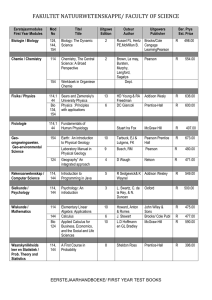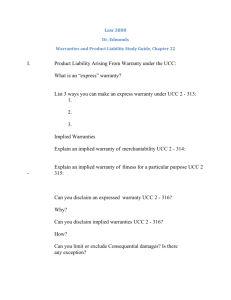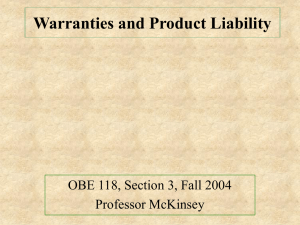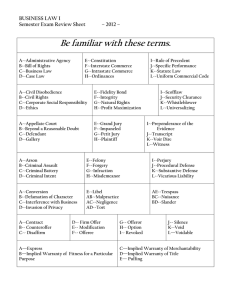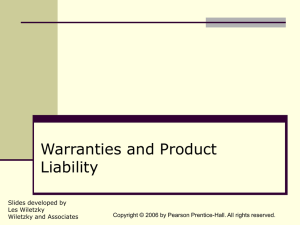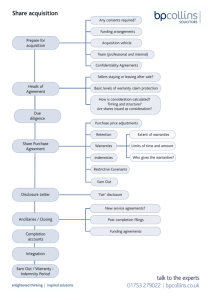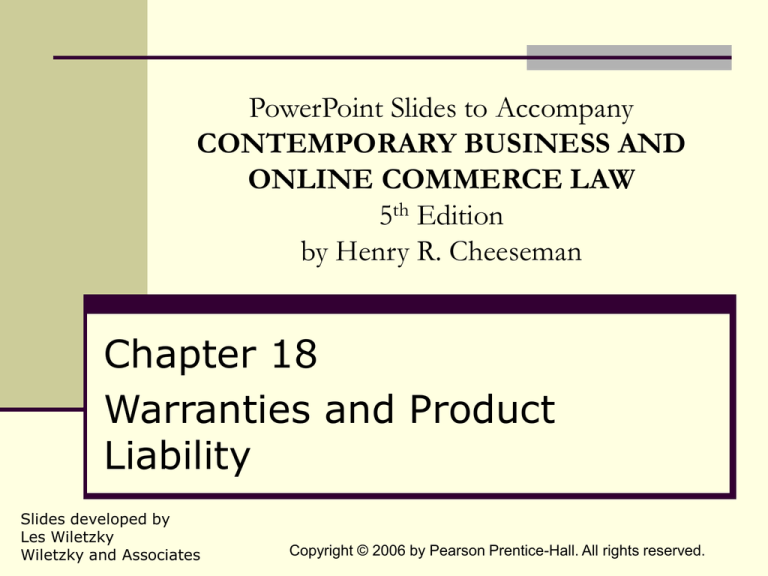
PowerPoint Slides to Accompany
CONTEMPORARY BUSINESS AND
ONLINE COMMERCE LAW
5th Edition
by Henry R. Cheeseman
Chapter 18
Warranties and Product
Liability
Slides developed by
Les Wiletzky
Wiletzky and Associates
Copyright © 2006 by Pearson Prentice-Hall. All rights reserved.
Introduction (1 of 2)
Article 2 of the Uniform Commercial Code
(UCC) establishes certain warranties that
apply to the sale of goods
Article 2A of the UCC establishes
warranties that apply in lease transactions
Consumers and others can sue to recover
damages caused by breach of warranty
Copyright © 2006 by Pearson Prentice-Hall. All rights reserved.
18 - 2
Introduction (2 of 2)
Warranty
A buyer’s or lessee’s
assurance that the
goods meet certain
standards
Products Liability
The liability of
manufacturers,
sellers, and others for
the injuries caused by
defective products
Copyright © 2006 by Pearson Prentice-Hall. All rights reserved.
18 - 3
Warranties of Quality
Seller’s or lessor’s assurance to buyer or
lessee that the goods meet certain
standards of quality
If the goods fail to meet a warranty, the
buyer or lessee can sue the seller or
lessor for breach of warranty
Warranties may be expressed or implied
Copyright © 2006 by Pearson Prentice-Hall. All rights reserved.
18 - 4
Express Warranties (1 of 2)
Created when a seller or lessor makes an
affirmation that the goods he or she is
selling or leasing meet certain standards
of quality, description, performance, or
condition [UCC 2-313(1); UCC 2A-210(1)]
It is not necessary to use formal words
such as warrant or guarantee to create an
express warranty [UCC 2-313(2); UCC
2A-210 (2)]
Copyright © 2006 by Pearson Prentice-Hall. All rights reserved.
18 - 5
Express Warranties (2 of 2)
Sellers and lessors are not required to
make such warranties
Basis of the Bargain – buyers and lessees
can recover for breach of an express
warranty if the warranty was a contributing
factor (not necessarily the sole factor) that
induced the buyer to purchase the product
or the lessee to lease the product [UCC 2313(1); UCC 2A-210(1)]
Copyright © 2006 by Pearson Prentice-Hall. All rights reserved.
18 - 6
Implied Warranty of Merchantability
(1 of 2)
Unless properly disclosed, a warranty is
implied when sold or leased goods are fit
for the ordinary purpose for which they are
sold or leased, and other assurances
[UCC 2-314(1); UCC 2A-212(1)]
The implied warranty of merchantability
does not apply to sales or leases by nonmerchants or casual sales
Copyright © 2006 by Pearson Prentice-Hall. All rights reserved.
18 - 7
Implied Warranty of Merchantability:
Standards That Must Be Met
The goods must be fit for the ordinary purposes for which they
are used
The goods must be adequately contained, packaged, and
labeled
The goods must be of an even kind, quality, and quantity within
each unit
The goods must conform to any promise or affirmation of fact
made on the container or label
The quality of the goods must pass without objection in the trade
Fungible goods must meet a fair average or middle range of
quality
Copyright © 2006 by Pearson Prentice-Hall. All rights reserved.
18 - 8
Implied Warranty of Fitness for
Human Consumption (1 of 2)
A warranty that applies to food or drink
consumed on or off the premises of:
Restaurants
Grocery stores
Fast-food outlets
Vending machines
Copyright © 2006 by Pearson Prentice-Hall. All rights reserved.
18 - 9
Implied Warranty of Fitness for
Human Consumption (2 of 2)
Consumer
Foreign Substance
Expectation Test
Test
A test to determine
A test to determine
merchantability based
merchantability based
on what the average
on foreign objects
consumer would
that are found in food
expect to find in food
products
Copyright © 2006 by Pearson Prentice-Hall. All rights reserved.
18 - 10
Implied Warranty of Fitness for a
Particular Purpose
A warranty that arises where a seller or
lessor warrants that the goods will meet
the buyer’s or lessee’s expressed needs
The warranty is breached if the goods do
not meet the buyer’s or lessee’s
expressed needs
The warranty applies to both merchant
and nonmerchant sellers and lessors
Copyright © 2006 by Pearson Prentice-Hall. All rights reserved.
18 - 11
Summary: Express and Implied
Warranties of Quality (1 of 2)
Type of Warranty How Created
Description
Express warranty
Affirmation that the goods meet
certain standards of quality,
description, performance, or
condition [UCC 2-313(1); UCC 2A210(1)]
Made by the seller or
lessor
Implied warranty Implied by law
for fitness for a
particular purpose
Copyright © 2006 by Pearson Prentice-Hall. All rights reserved.
Implied that the goods are fit for the
purpose for which the buyer or
lessee acquires the goods [UCC 2315; UCC 2A-213]
18 - 12
Summary: Express and Implied
Warranties of Quality (2 of 2)
Type of Warranty
How Created
Implied warranty of Implied by law if the
merchantability
seller or lessor is a
merchant
Description
Implied that the goods:
1.
Are fit for the ordinary purposes for
which they are used
2.
Are adequately contained,
packaged, and labeled
3.
Are of an even kind, quality, and
quantity within each unit
4.
Conform to any promise or
affirmation of fact made on the
container or label
5.
Pass without objection in the trade
6.
Meet a fair average or middle range
of quality for fungible goods [UCC
2-314(1); UCC 2A-212(1)]
Copyright © 2006 by Pearson Prentice-Hall. All rights reserved.
18 - 13
Warranty Disclaimers
Warranties can be disclaimed or limited
If an express warranty is made, it can only
be limited if the disclaimer and the
warranty can he reasonably construed
with each other
All implied warranties of quality may be
disclaimed by expressions like as is, with
all faults, or other language that makes it
clear to the buyer that there are no implied
warranties
Copyright © 2006 by Pearson Prentice-Hall. All rights reserved.
18 - 14
Conspicuous Display of Disclaimer
Written disclaimers must be
conspicuously displayed to be valid
Conspicuous – construed by the courts
as noticeable to a reasonable person
[UCC 2-316; UCC 2A-214]
Copyright © 2006 by Pearson Prentice-Hall. All rights reserved.
18 - 15
Magnuson-Moss Warranty Act (1 of 2)
Federal statute that regulates express full
and limited warranties made by sellers
and lessors
The Act does not require a seller or lessor
to make express written warranties
However, persons who do make such
warranties are subject to the provisions of
the Act
Copyright © 2006 by Pearson Prentice-Hall. All rights reserved.
18 - 16
Magnuson-Moss Warranty Act (2 of 2)
The Act does not create any implied
warranties
However, sellers or lessors who make
express written warranties relating to
consumer products are forbidden from
disclaiming or modifying the implied
warranties of merchantability and fitness
for a particular purpose
Copyright © 2006 by Pearson Prentice-Hall. All rights reserved.
18 - 17
Product Liability Based on Fault:
Misrepresentation
A buyer or lessee who is injured because a seller or
lessor fraudulently misrepresented the quality of a
product can sue the seller under the tort of intentional
misrepresentation
Seller or lessor either:
Affirmatively misrepresents the quality of a product; or
Conceals a defect in it
Recovery is limited to persons who were injured
because they relied on the misrepresentation
Copyright © 2006 by Pearson Prentice-Hall. All rights reserved.
18 - 18
Product Liability Based on Fault:
Negligence
Negligence – a tort related to defective products where
the defendant has breached a duty of care and caused
harm to the plaintiff
Failure to exercise due care includes:
Failing to assemble the product carefully
Negligent product design
Negligent inspection or testing of the product
Negligent packaging
Failure to warn of the negligent propensities of the
product
Copyright © 2006 by Pearson Prentice-Hall. All rights reserved.
18 - 19
Landmark Case:
McPherson v. Buick Motor Company
The court held that an injured consumer
could recover damages from the
manufacturer of a product even though he
or she was only in privity of contract with
the retailer from whom he or she had
purchased the product
Copyright © 2006 by Pearson Prentice-Hall. All rights reserved.
18 - 20
Other Warranty Issues
Overlapping and inconsistent warranties
Warranty disclaimers
Conspicuous display of disclaimer
Unconscionable disclaimers
Warranty disclaimers in software licenses
Third-party beneficiaries of warranties
Copyright © 2006 by Pearson Prentice-Hall. All rights reserved.
18 - 21
Strict Liability
In Greenmun v. Yuba Power Products,
Inc., the California Supreme Court
adopted the doctrine of strict liability in tort
as a basis for product liability actions
Most states have adopted this doctrine as
the basis for product liability actions
Removes many of the difficulties for the
plaintiff associated with other theories of
product liability
Copyright © 2006 by Pearson Prentice-Hall. All rights reserved.
18 - 22
Strict Liability: Chain of Distribution
All parties in the chain of distribution of a
defective product are strictly liable for the
injuries caused by that product
All manufacturers, distributors,
wholesalers, retailers, lessors, and
subcomponent manufacturers may be
sued under this doctrine (doctrine of strict
liability in tort)
Copyright © 2006 by Pearson Prentice-Hall. All rights reserved.
18 - 23
Strict Liability:
Parties Who Can Recover
Privity of contract is not required for a
plaintiff to sue for strict liability
The doctrine applies even if the injured
party had no contractual relations with the
defendant
The damages recoverable in a strict
liability action vary by jurisdiction
Copyright © 2006 by Pearson Prentice-Hall. All rights reserved.
18 - 24
Strict Liability: Damages Recoverable
Punitive damages are often awarded in
strict liability lawsuits if the plaintiff proves
that the defendant either:
Intentionally injured him or her; or
Acted with reckless disregard for his or her
safety
Copyright © 2006 by Pearson Prentice-Hall. All rights reserved.
18 - 25
Doctrines of Negligence and Strict Liability
Compared
Negligence Lawsuit
Defendant
Manufacturer
(negligent)
Defendant
Strict Liability
Lawsuit
Defective product
Distributor
Defendant
Negligent party is
liable
Retailer
Negligence
lawsuit
Consumer
Defendant
All in the chain of
distribution are
liable
Strict liability
lawsuit
Defective product causes injury
Copyright © 2006 by Pearson Prentice-Hall. All rights reserved.
18 - 26
The Concept of Defect
To recover for strict liability, the injured
party must first show that the product that
caused the injury was somehow defective
Plaintiffs can allege multiple product
defects in one lawsuit
Copyright © 2006 by Pearson Prentice-Hall. All rights reserved.
18 - 27
Common Types of Defects
1. Defects in
Manufacture
2. Defects in
Design
3. Defects in
Packaging
4. Failure to Warn
Copyright © 2006 by Pearson Prentice-Hall. All rights reserved.
18 - 28
Crashworthiness Doctrine
The courts have held that automobile
manufacturers are under a duty to design
automobiles so they take into account the
possibility of harm from a person’s body
striking something inside the automobile in
the case of a car accident.
Copyright © 2006 by Pearson Prentice-Hall. All rights reserved.
18 - 29
Other Product Defects
Failure to provide adequate instructions
Inadequate testing of products
Inadequate selection of component parts
or materials
Improper certification of the safety of a
product
Copyright © 2006 by Pearson Prentice-Hall. All rights reserved.
18 - 30
Defenses to Product Liability
1. Supervening Event
5. Misuse of the Product
2. Generally Known
Dangers
6. Statute of Limitations
3. Assumption of the Risk
7. Contributory and
Comparative Negligence
4. Government Contractor
Defense
Copyright © 2006 by Pearson Prentice-Hall. All rights reserved.
18 - 31
International Law:
Product Liability in Japan (1 of 2)
Product liability claims are rare in Japan
for several reasons:
1. The plaintiff has the difficult burden of
proving that the company was negligent
2. Japanese courts do not allow discovery
3. Claimants must pay a percentage of any
damages requested (not won) as court
fees
Copyright © 2006 by Pearson Prentice-Hall. All rights reserved.
18 - 32
International Law:
Product Liability in Japan (2 of 2)
4. Awards granted by courts are small (by
U.S. standards)
5. Punitive damages are not available
Copyright © 2006 by Pearson Prentice-Hall. All rights reserved.
18 - 33

